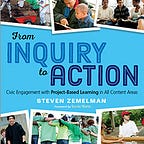How Do We Help Good Students Understand Why Some of Their Peers Seem Not to Care?
I guess I’m especially aware of teaching dilemmas lately. Perhaps it’s a function of age — or the age we’re in. Anyway, here’s one that’s on my mind now.
I work with students on four restorative justice teams at a high school with a high proportion of low income students — about two thirds Mexican American and one third African American. But put aside the race relationships for a moment and consider another divide: In discussing conditions in the school the stronger, more learning-oriented students view their less engaged peers as simply not caring. “They just don’t take advantage of the help that’s available here,” they tell me. Indeed, there’s a level of passivity among many at the school that seems intractable to those of us aching to promote student activism and success. And the more active students perceive this as purely a matter of individual responsibility rather than a response to the social structure.
Those of us who study the psychology, social conditions, and political context of education know how these things make students’ lives challenging and their sense of their future discouraging. Of course, building teacher-student trust can bring them into engagement. And helping young people talk through their issues and struggles can enable them to see more of a future for themselves. But no thanks to the brutal context in our city and country there are simply not the resources to help every kid. Anyway, helping individuals doesn’t change that larger context.
So how do I help the active kids begin to see their fellow students differently? To what extent do I turn my once-a-week 50-minute lunchtime session with each team into a class on social injustice and inequality and what it does to the psyches of young people?
Actually, writing this makes me want to try. Nevertheless I worry. Ben Kirshner, in Youth Activism in an Era of Education Inequality (New York University Press 2015 — get it and read it!), describes the struggles of activist teachers and coaches to balance teaching and directing students with giving them initiative and decision-making opportunities. We want to deepen their understanding but not at the cost of taking away their initiative and sense of agency.
I’m thinking of bringing in one of the school counselors or Youth Guidance counselors (this Chicago organization works in a number of Chicago high schools to help youth find positive directions in their lives) to talk about this — so it isn’t just me talking at the kids. I’ll keep blog readers posted!
